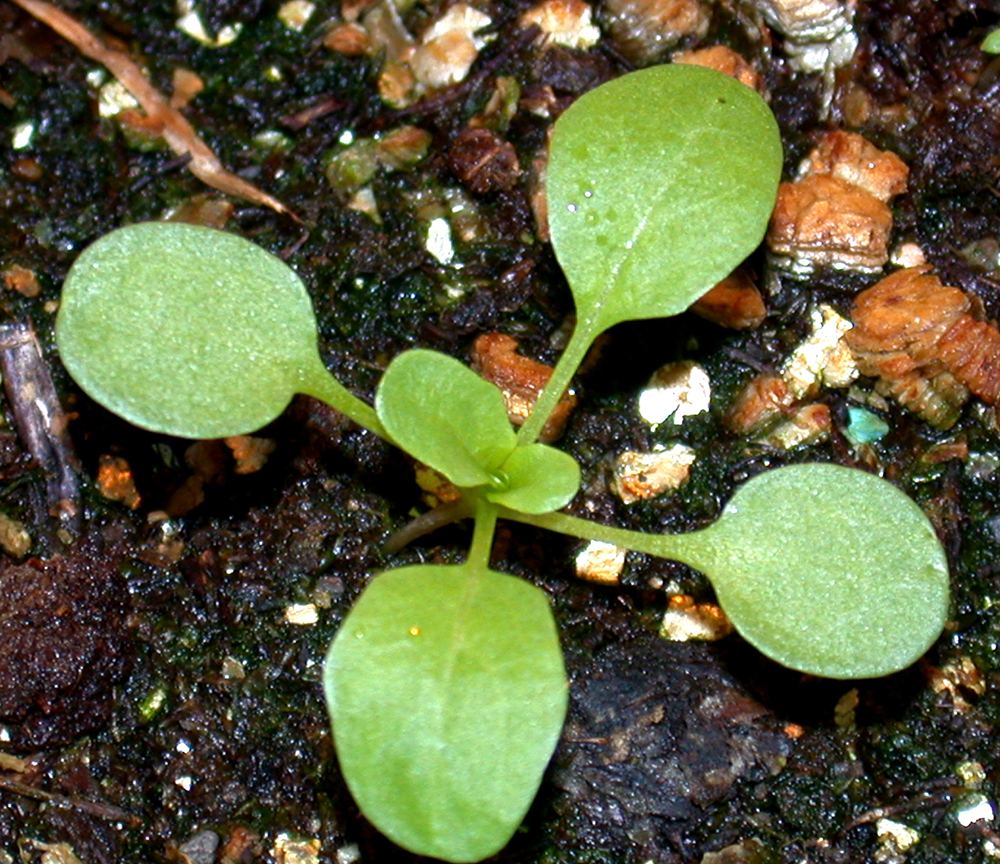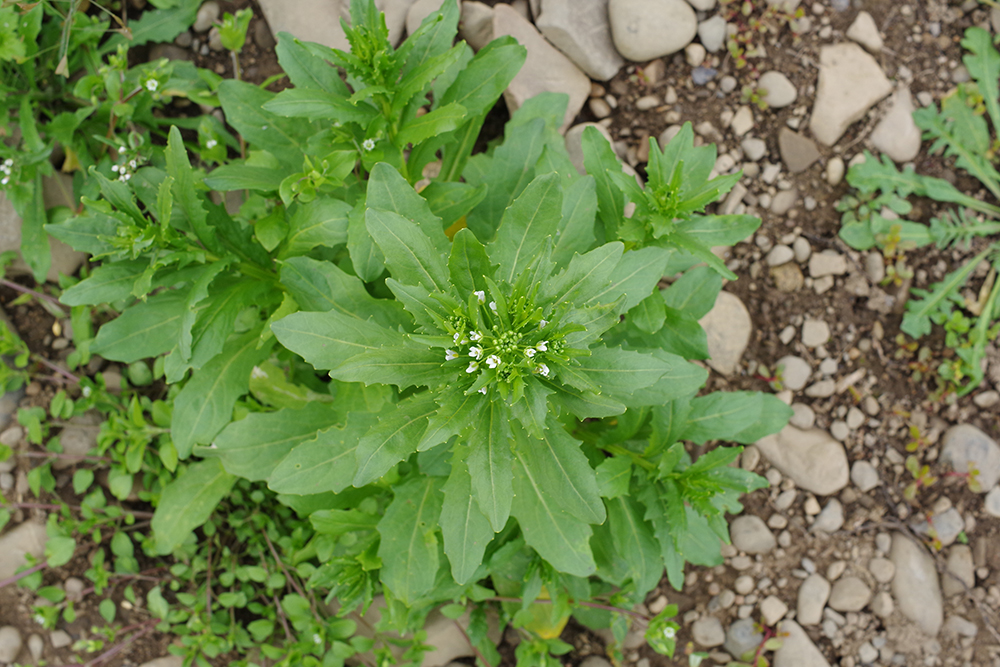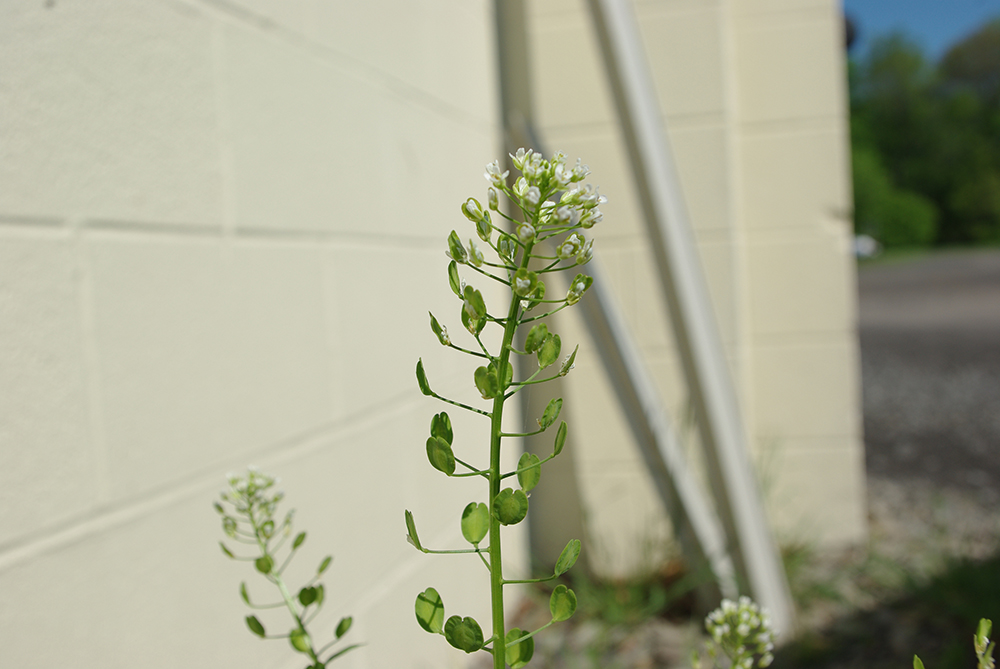Other common names: bastardcress, fanweed, stinkweed, mithridate mustard, frenchweed, French weed, bastardweed, dish mustard, field thlaspi



Thlaspi arvense L.
Identification of Field Pennycress
Family: Mustard family, Brassicaceae
Habit: Erect, branched, summer or winter annual herb
Description: Cotyledons are hairless, unequally sized, 0.2–0.4 inch long by 0.1–0.3 inch wide, oval shaped and bluish-green in color. The first leaves on the seedling are opposite and oval shaped, with wavy margins; all subsequent leaves are alternate. Young leaves form a basal rosette. Mature plants reach 20–32 inches tall. Basal leaves are long stalked (0.5–2 inches); the pale green blades are hairless, 1–2.5 inches long, egg shaped and widest above the middle; they wither at maturity. Stem leaves are stalkless, dark green, irregularly toothed, lanceolate to linear, 0.75–2 inches long and tapered; they persist to maturity. Pointed auricles are present at the base of stem leaves. An extensive, fibrous root system extends from a thin taproot. All plant parts exude an unpleasant odor when crushed. Flowers are inconspicuous, 0.13 inch wide, have four white petals and are clustered at stalk ends. The stalk continues to elongate at maturity, producing new flowers at its tip and maturing seeds below. Seedpods are round, 0.5 inch wide and flat with winged, papery edges. Seedpods have a central line and a notched tip. Seeds are light to dark brown or purplish, 0.06 inch long and egg shaped. Seeds have one straight side, one round side and distinctive fingerprint-like surface ridges.
Similar species: Shepherd’s-purse [Capsella bursa-pastoris (L.) Medik.] seedpods are more heart or triangular shaped, and the flower stalks are mostly leafless and unbranched. Thoroughwort pennycress [Microthlaspi perfoliatum (L.) F.K. Mey.] has smaller seeds contained in 0.25 inch-long seedpods and has rounded auricles.
Management of Field Pennycress
Delaying planting of both spring and fall seeded crops allows more field pennycress seeds to germinate before tillage. Where feasible, rotation with summer planted crops reduces field pennycress populations, but only if the weed is prevented from setting seed in the spring before planting. Early spring cultivation during the fallow year of grain-fallow rotations will prevent seed production and will improve good control. Otherwise, field pennycress produces seeds exceptionally early in the spring, and substantial seed input can occur in fallow fields while other fields are being prepared and planted with crops. Some winter wheat varieties are substantially more competitive against this weed than others (Holm et al. 1997), and the same probably applies for other grains. Tall, leafy, small grain varieties are likely to be more competitive since this species does not tolerate shade. Banding N in grain crops decreases the density of field pennycress. A substantial fraction of field pennycress seedlings can be selectively removed from many crops with well-timed tine weeding, but usually many will survive. Unlike most annual weeds, field pennycress populations are not reduced by rotation into alfalfa. Fall germination and early spring seed production allows field pennycress to complete its life cycle while avoiding competition with alfalfa. Also, mowing causes branching and rapid regrowth, with little reduction in final plant size or seed production. Smooth brome and crested wheatgrass, however, effectively suppress field pennycress.
Use dense winter cover crops of rye or spelt to suppress field pennycress in vegetable crops, but be sure to incorporate these in the spring before the weed goes to seed. Rework the seedbed before planting to flush seeds out of the soil and kill seedlings. Tine weed or hoe around crops until they are well established to eliminate early flushes.
Ecology of Field Pennycress
Origin and distribution: Field pennycress originated in Eurasia and is widespread from Japan to Spain. It is present throughout the United States and in Canada as far north as the Yukon, but it is most problematic in the northern Great Plains region. It has also been introduced into Australia, New Zealand and Argentina.
Seed weight: 0.74–1.5 mg.
Dormancy and germination: Various strains of the species show differing germination behavior. In most field-grown populations, seeds are dormant when shed from the parent plant and require an additional month or more of after-ripening. Seeds of various strains respond differently to cold. For some non-dormant strains, cold temperatures, for example 36°F, induce deep dormancy that is only broken by exposure of the seeds to several months of warmer temperatures (43–95°F). In other dormant strains, several weeks of cold temperatures break dormancy. Regardless of strain, during the transition between dormancy and non-dormancy, germination is promoted by red light but inhibited by light filtered through a crop canopy. Nitrate and day/night temperature fluctuations also promote germination of non-dormant seeds. All of these factors probably contribute to the flush of germination that commonly follows fertilization and tillage. Non-dormant seeds are capable of optimum germination at a wide range of day/night temperatures, from 59/43°F to 95/68°F. Germination of this species requires relatively higher soil moisture compared to crops.
Seed longevity: The seeds can persist 17–30 years in undisturbed soil. In a five-year experiment, the number of field pennycress seeds declined by 50% per year in soil stirred four times per year, but only 10% per year in undisturbed soil.
Season of emergence: Most emergence occurs in the spring; relatively few individuals emerge in mid-summer, and a second, usually smaller, peak in emergence occurs in the fall. In Wisconsin, field pennycress is among the earliest weeds to emerge in spring.
Emergence depth: Most seedlings of field pennycress emerge from the top 0.8 inch of soil. The emergence requirements of a shallow seed depth combined with high soil moisture may explain why non-dormant seeds capable of germinating at high temperatures do not emerge in mid-summer when surface soil is usually dry.
Photosynthetic pathway: C3
Sensitivity to frost: The species is very cold hardy, and cold acclimated plants can survive 7°F with little damage. Fall germinating individuals overwinter and flower the following spring.
Drought tolerance: The root system of field pennycress has a higher density and total length than most grain crops and other weeds, which makes the species a good competitor for moisture. Relative to other species, however, field pennycress requires more water per unit of growth.
Mycorrhiza: This species is non-mycorrhizal.
Response to fertility: Plant size increases steadily with increasing N application rate up to 143 pounds per acre. Field pennycress has been categorized as intermediate in N response relative to other weed species. The species also continues to respond to phosphorus fertilization up to very high application rates.
Soil physical requirements: Field pennycress occurs on all types of soil suitable for crop production.
Response to shade: The species is intolerant of shade and usually cannot push through a crop canopy.
Sensitivity to disturbance: Removal of the shoot tip increases branching but has little effect on mature plant weight or seed production. Seeds in green pods will continue to mature even after being plowed under.
Time from emergence to reproduction: Plants establishing in the spring flower five to seven weeks after emergence, whereas overwintering plants flower a month earlier. The seeds require about two weeks to fully mature; however, immature seeds become viable as little as six days after pollination.
Pollination: Self-pollination is common, but 10–20% of flowers are cross pollinated by insects.
Reproduction: Spring emerging plants grown in the field in Saskatchewan with little competition produced an average of 14,000 seeds per plant, whereas fall emerging plants produced an average of 9,400 seeds per plant. Field pennycress averaged 300 seeds per plant in high density monocultures.
Dispersal: Seeds are dispersed in soil on tires, field machinery, shoes and combines. It is commonly found in manure and can survive digestion in the guts of transported livestock. Viable seeds have been recovered from droppings of several species of wild birds. It is also a common contaminant of grain and forage seed, which is a major way it has moved between continents. The seeds disperse short distances with wind and longer distances in irrigation water.
Common natural enemies: Field pennycress is susceptible to the pathogens and insects that commonly attack crops in the mustard family, but there is no record that damage levels are detrimental to growth or reproduction. Carabid beetle activity was highly correlated with field pennycress seed predation from the soil surface; losses from fields in late summer averaged 23% per week.
Palatability: Consumption by cattle gives meat and milk an unpleasant flavor and in large quantities can cause poisoning. Field pennycress seeds can contaminate canola and lower the quality of canola oil. The species is cultivated in parts of Europe for the tender young shoots, which are eaten in salads or cooked like spinach.
Note: Field pennycress is currently being domesticated as a winter annual oilseed crop that would be complementary with a corn-soybean rotation in the upper Midwest. It also has potential as a winter hardy cover crop that can provide early spring pollinator services.
Summary Table of Field Pennycress Characteristics
| Field pennycress | ||||||||
|---|---|---|---|---|---|---|---|---|
| Growth habit | Seed weight (mg) | Seed dormancy at shedding | Factors breaking dormancy | Optimum temperature for germination (F) | Seed mortality in untilled soil (%/year) | Seed mortality in tilled soil (%/year) | Typical emergence season | Optimum emergence depth (inches) |
| medium, branched | 0.8–1.5 | Yes | cms, wst, li, at, ni | 59/43 to 95/68 | 10 | 50 | spring and fall | 0-0.8 |
| Photosynthesis type | Frost tolerance | Drought tolerance | Mycorrhiza | Response to nutrients | Emergence to flowering (weeks) | Flowering to viable seed (weeks) | Pollination | Typical & high seed production (seeds per plant) |
| C3 | high | low | no | moderate | 5–7 | 1–2 | self, can cross | 500 & 14,000 |
Table Key
General: The designation “–” signifies that data is not available or the category is not applicable.
Growth habit: A two-word description; the first word indicates relative height (tall, medium, short, prostrate) and second word indicates degree of branching (erect, branching, vining).
Seed weight: Range of reported values in units of “mg per seed.”
Seed dormancy at shedding: “Yes” if most seeds are dormant when shed, “Variable” if dormancy is highly variable, “No” if most seeds are not dormant.
Factors breaking dormancy: The principle factors that are reported to break dormancy and facilitate germination. The order of listing does not imply order of importance. Abbreviations are:
scd = seed coat deterioration
cms = a period subjected to cold, moist soil conditions
wst = warm soil temperatures
li = light
at = alternating day-night temperatures
ni = nitrates
Optimum temperature range for germination: Temperature (Fahrenheit) range that provides for optimum germination of non-dormant seeds. Germination at lower percentages can occur outside of this range. The dash refers to temperature range, and the slash refers to alternating day/night temperature amplitudes.
Seed mortality in untilled soil: Range of mortality estimates (percentage of seed mortality in one year) for buried seeds in untilled soil. Values were chosen where possible for seeds placed at depths below the emergence depth for the species and left undisturbed until assessment. Mortality primarily represents seed deterioration in soil.
Seed mortality in tilled soil: Range of mortality estimates (percentage of seed mortality in one year) for seeds in tilled soil. Values were chosen for seeds placed within the tillage depth and subjected to at least annual tillage events. Seed losses are the result of dormancy-breaking cues induced by tillage, germination and deterioration of un-germinated seeds.
Typical emergence season: Time of year when most emergence occurs in the typical regions of occurrence for each weed. Some emergence may occur outside of this range.
Optimum emergence depth: Soil depths (in inches below the soil surface) from which most seedlings emerge. Lower rates of emergence usually will occur at depths just above or just below this range.
Photosynthesis type: Codes “C3” or “C4” refer to the metabolic pathway for fixing carbon dioxide during photosynthesis. Generally, C3 plants function better in cooler seasons or environments and C4 plants function better in warmer seasons or environments.
Frost tolerance: Relative tolerance of plants to freezing temperatures (high, moderate, low).
Drought tolerance: Relative tolerance of plants to drought (high, moderate, low).
Mycorrhiza: Presence of mycorrhizal fungi. “Yes” if present; “no” if documented not to be present, “unclear” if there are reports of both presence and absence; “variable” if the weed can function either with or without, depending on the soil environment.
Response to nutrients: Relative plant growth response to the nutrient content of soil, primarily N, P, K (high, moderate, low).
Emergence to flowering: Length of time (weeks) after emergence for plants to begin flowering given typical emergence in the region of occurrence. For species emerging in fall, “emergence to flowering” means time from resumption of growth in spring to first flowering.
Flowering to viable seed: Length of time (weeks) after flowering for seeds to become viable.
Pollination: “Self” refers to species that exclusively self-pollinate, “cross” refers to species that exclusively cross-pollinate, “self, can cross” refer to species that primarily self-pollinate, but also cross-pollinate at a low rate, and “both” refers to species that both self-pollinate and cross-pollinate at relatively similar rates.
Typical and high seed production potential: The first value is seed production (seeds per plant) under typical conditions with crop and weed competition. The second value, high seed production, refers to conditions of low density without crop competition. Numbers are rounded off to a magnitude that is representative of often highly variable reported values.
Further Reading
Holm, L., J. Doll, E. Holm, J. Pancho and J. Herberger. 1997. World Weeds: Natural Histories and Distribution. John Wiley & Sons: New York, NY.
Mitich, L.W. 1996. Field pennycress (Thlaspi arvense L.): The stinkweed. Weed Technology 10: 675–678.
Warwick, S.I., A. Francis and D.J. Susko. 2002. The biology of Canadian weeds. 9. Thlaspi arvense L. (updated). Canadian Journal of Plant Science 82: 803–823.

